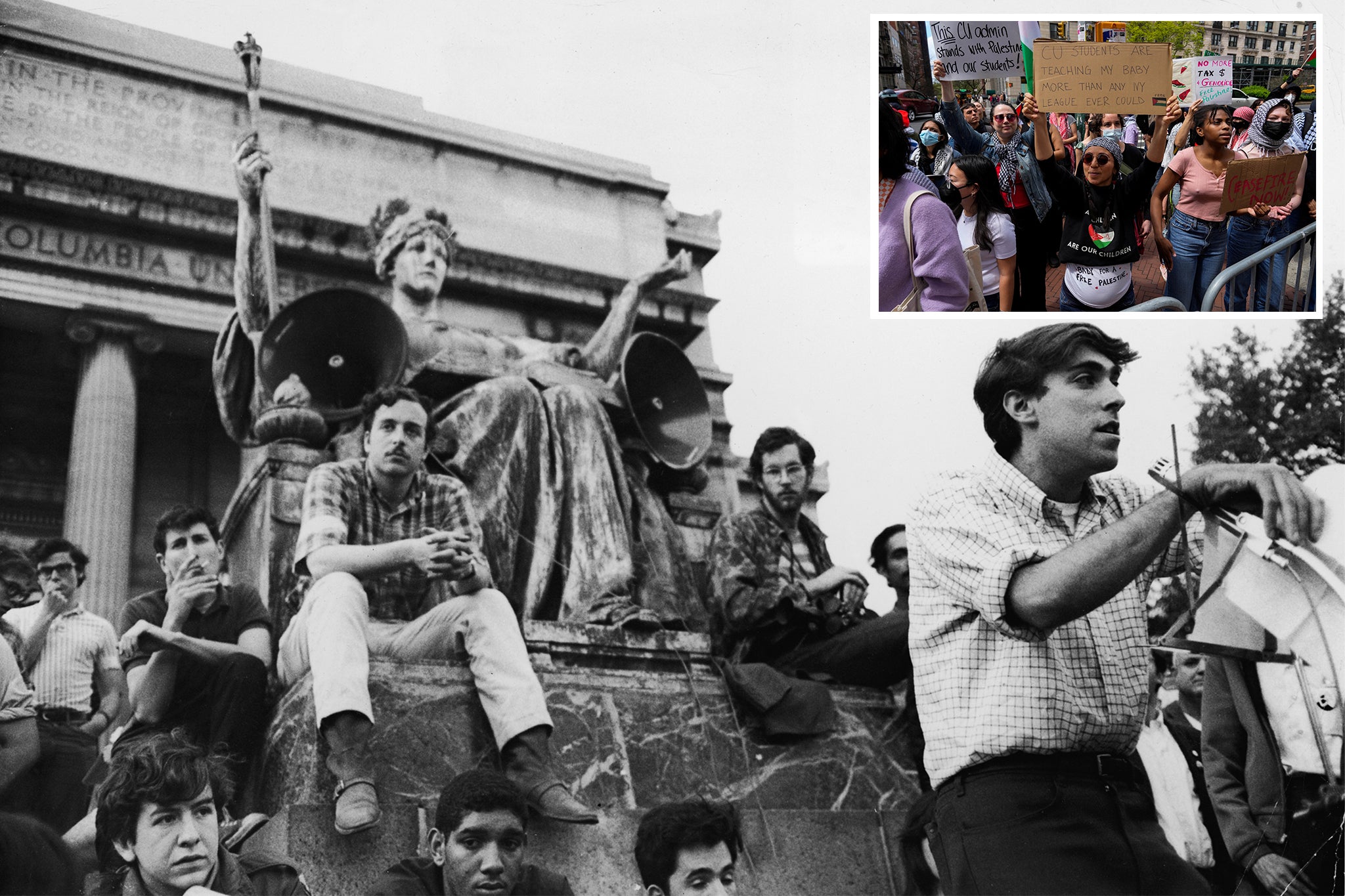Columbia’s protesting students have much to learn from the 1960s ‘glory days’
How many parallels can really be drawn between the pro-Palestine sit-ins disrupting American campuses and the civil rights campaigns that sparked violent clashes – and helped achieve significant societal change – more than half a century ago? Surprisingly few, says Mary Dejevsky


As the calendar turned from April to May, police marched onto the campuses of two major universities, one on each coast of the United States, and dispersed hundreds of students. At Columbia University in New York City, the students – protesting in support of Palestinians in Gaza – mostly went peacefully, and their occupation of the historic Hamilton Hall, if not their campus encampment, came to an end. It was another story at the University of California, Los Angeles (UCLA), where violent scuffles broke out, first between pro-Palestinian and pro-Israel groups among the students themselves, and then with the police.
To many Americans – and not just Americans – these protests and the manner of their dispersal, by serried ranks of super-confident “cops”, represented a lot more than a here today, gone tomorrow news story. They brought back memories and invited parallels with the now legendary student protests of the late 1960s and early 1970s. To make the point, many media outlets – mainly in the US, but in Europe, too – interspersed the brightly coloured mobile phone footage from today with grainy black-and-white clips from then.
Even those who are too young to remember, let alone to have taken part in those protests – the vast majority of Americans – will have imbibed something of what happened then from their parents and grandparents, as from photo-histories proudly displayed by the universities concerned. The campus protests and occupations of more than 50 years ago were glory days, seen by participants then and historians now as righteous challenges to the misuse of state power – the war in Vietnam and the draft – and to the entrenched social injustice that consigned Black Americans to the status of second-class citizens.
Those protests had their own heroes and martyrs: the four students killed by the National Guard at Ohio’s Kent State University in 1970, in circumstances that remain disputed to this day. Nor, in university quarters, does it take much to ignite the memories, real and folk, of a country that seemed to many at the time to be on the brink of more widespread disorder. What is more, the scale of today’s largely pro-Palestinian protests, expressed in marches, sit-ins, tent encampments and the occupation of academic buildings right across the United States, may indeed come closest to what the US experienced back then.
To some, the fierce disagreements about what constitutes free speech, the #MeToo movement, Trumpism, and a whole lot else that makes up the so-called culture wars, are all evidence that the United States is in the grip of the same dangerously febrile political and philosophical forces as it was then. The next step, so the script might go, could be violence – the largely unspoken context of the US box-office success Civil War, just released in the UK.
Before today’s US student demonstrators definitively claim the mantle of the Vietnam and civil rights protesters of half a century ago, however, it is worth asking how many parallels there really are. And here, the answer – as supplied by some of those who really were there (and remember that they were there) – is not many. As one of those too young to be there, but with relatives who were, I would agree.
One key difference, so far at least, is headcount. Although the television footage makes today’s demonstrations look huge, the actual numbers involved are still small in comparison with the massive social and academic unrest of the late 1960s and early 1970s.
Another is the willingness, of some institutions at least, to call in the police. Universities in general and US universities in particular pride themselves on essentially policing themselves. The president of Columbia, Minouche Shafik – who, incidentally, only took over the job in 2022, after five years heading the London School of Economics and, before that, a stint as deputy governor of the Bank of England – called in the police on day two of the first encampment springing up, citing what she called “a clear and present danger to the substantial functioning of the university”.
She also appeared to have little compunction about threatening protestors with suspension or expulsion. What is more, at Columbia – though less so, it would appear, at UCLA – most of the students went quietly, although they resumed their encampment. Such disciplinary threats would largely have been futile in the earlier protests, as many campuses were in a state of open revolt.
Perhaps the greatest difference, however, is that the 1960s protests concerned issues that affected the students directly, relating to the policies and social fabric of their own country. There were the rights and mostly wrongs of the Vietnam war, the draft, and the lack of basic civil rights for many Black Americans. The issues were both distinct and related, and contributed to a veritable surge of protest that was also generational, with older children pitted against their parents.
Very little of that translates to today. It is hard to see the plight of Palestinians in Gaza as a direct concern for US and other students. Their protests can be seen at best as altruistic, and emblematic of an internationalised world, where instant communications and social media encourage people to associate themselves with causes beyond their borders. Does this make it more or less laudable that students may be putting their futures on the line for the sake of a cause that is only theirs in the sense that it can be seen as universal?
I will leave that question hanging, beyond observing that, until the 7 October attacks, I had attended events where almost no one under 40 had shown particular knowledge of or interest in the Palestinian cause; the name Yasser Arafat meant almost nothing. As for the international threat from PLO terrorism, you would be hard put to find anyone of student age, beyond those with a Palestinian or wider Middle Eastern background, who knew anything about it.
Nor has that necessarily changed. What people across the Western world have locked onto is what is happening to Palestinians now, and their cause has become, in a way, an injustice that stands for many. The difficulty facing not just US institutions is that this cause clashes with the deeply held claim of Jews to their own security and their own state.
A conflict in the Middle East, transmitted around the world in real time, replicates itself elsewhere in clashes on campus (as at UCLA) and elsewhere, with charges of antisemitism – sometimes warranted, sometimes not. The student body, like public opinion more broadly, may be divided, presenting big dilemmas to administrators, teachers and law enforcement alike.
If the parallels between then and now are less than they might appear, so too are any parallels that might be drawn between their respective results – although the balance of achievement might be reversed. After all, what did the student protests of 1968 really achieve?
They may have helped, but they did not, by themselves, end the Vietnam war, which had its own denouement on the ground. Nor did they force the resignation of Richard Nixon, which was largely his own doing. Student engagement might have bolstered the civil rights movement, but the marches and achievements would probably have happened without them. With hindsight, the student revolts look more like the symptoms of profound social change rather than its cause.
The current protests may be seen in the same way, as symptom rather than cause, of a big change in US opinion. In recent months, Joe Biden has gradually adjusted US policy on Gaza to the point of openly criticising Israel, and it is hard to see that he would have done that just to please critics abroad.
Viewed in retrospect, the campus protests of 2024 may be seen as the harbinger of a historic shift in US policy in the Middle East. It would be explained partly by real-time information about the war in Gaza, partly by the growing, albeit still small number of Muslims in the US, partly by a decline in the influence of the American Israel lobby.
It is a change that can be seen as both generational and philosophical – and one in which ferment on campus may have helped to lead the way.
Join our commenting forum
Join thought-provoking conversations, follow other Independent readers and see their replies
Comments
Bookmark popover
Removed from bookmarks